Index to Flowers in the Order Gentianales
Family: Apocynaceae
Adenium multiflorum Impala Lily viewtopic.php?f=248&p=143857#p143857
Adenium swazicum Swazi Lily, Summer Impala Lily viewtopic.php?f=248&t=3727&p=11838#p175390
Catharanthus roseus Madagascar Periwinkle viewtopic.php?p=232749#p232749
Gomphocarpus fruticosus fruticosus Balloon Plant, Milkweed, Wild Cotton viewtopic.php?p=238365#p238365
Gomphocarpus physocarpus Balloon Plant, Balloon milkweed, Balloon Wild Cotton viewtopic.php?f=248&t=3727&p=11838#p170467
Hoodia currorii lugardii Hoodia viewtopic.php?f=248&t=3727&p=187934#p187934
Hoodia gordonii Bushveld Ghaap, Hoodia viewtopic.php?f=248&t=3727&p=178849#p178849
Pachypodium saundersii Kudu Lily viewtopic.php?f=248&t=3727#p170468
Family: Gentianaceae
Chironia baccifera Christmas Berry viewtopic.php?p=301594#p301594
Chironia palustris transvaalensis Transvaal Chironia viewtopic.php?p=197193#p197193
Chironia purpurascens Dwarf Chironia viewtopic.php?p=197187#p197187
Sebaea exacoides Orange-throat Yellowwort viewtopic.php?p=235727#p235727
Family: Rubiaceae
Kohautia cynanchica Kohoutia viewtopic.php?f=248&t=3727&p=170467#p170664
Pentanisia angustifolia Pentanisia viewtopic.php?f=248&t=3727&p=170467#p170686
Pentanisia prunelloides prunelloides Wild Verbena viewtopic.php?p=529182#p529182
Spermacoce natalensis False Buttonweed viewtopic.php?f=248&p=170690#p170690
Africa Wild Flower Book - Order Gentianales
Moderator: Klipspringer
- Flutterby
- Posts: 44029
- Joined: Sat May 19, 2012 12:28 pm
- Country: South Africa
- Location: Gauteng, South Africa
- Contact:
Re: Africa Wild Plant Book: Trees & Shrubs
Impala Lily Adenium multiflorum (Impalalelie)
Order Gentianales. Family: Apocynaceae
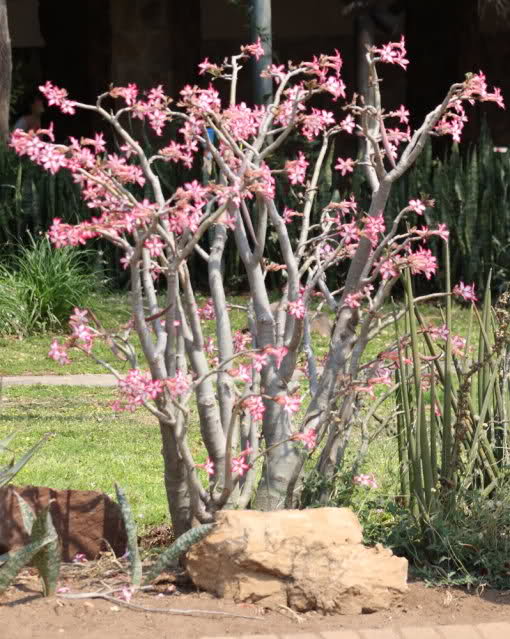
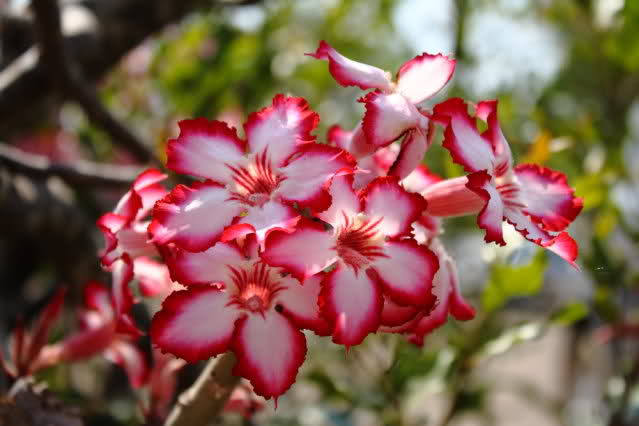
Description
Adenium multiflorum is a deciduous succulent shrub or small tree, 30 cm to 3 m tall, the shape resembling a miniature baobab. Silvery-grey, swollen stems arise from a large underground rootstock. The bark is shiny grey to brown, with poisonous watery latex. For most of the year the plants do not have flowers or leaves. The leaves are crowded near the ends of branches, up to 100 mm long, shiny green above and pale below, usually much broader towards the tip, and are carried in clusters at the growing tips of the branches. They are shed before flowering.
The flowers are borne in terminal inflorescences, each flower 50-70 mm in diameter. They vary greatly in colour, usually with pointed white lobes, crinkly red margins and red stripes in the throat. Plants with pure white flowers are occasionally found. The flowers are sweetly scented. Flowering occurs from May to September. The fruit is usually paired, cylindrical follicles up to 240 mm long. The seeds are brown with a tuft of silky hairs. The large, cigar-shaped pods burst open when ripe to release masses of small seeds.
Distribution
The natural distribution range of Adenium multiflorum extends from southeastern Zambia, through Malawi, Zimbabwe and Mozambique, to Limpopo, Mpumalanga and the northern parts of KwaZulu-Natal in South Africa, and Swaziland.
Habitat
These plants are usually found in sandy soil or in alluvium in rocky habitats, in dry woodland or open grassland, on brackish flats. They are found mainly in frost-free areas of the lowveld and eastern parts of southern Africa, south of the Zambezi River, from sea level to elevations of up to 1 200 m. Although A. multiflorum grows only in the extreme eastern parts of South Africa, it is widely distributed in the central and eastern parts of Africa.
 © Dewi
© Dewi
Kruger National Park, Shingwedzi
Order Gentianales. Family: Apocynaceae


Description
Adenium multiflorum is a deciduous succulent shrub or small tree, 30 cm to 3 m tall, the shape resembling a miniature baobab. Silvery-grey, swollen stems arise from a large underground rootstock. The bark is shiny grey to brown, with poisonous watery latex. For most of the year the plants do not have flowers or leaves. The leaves are crowded near the ends of branches, up to 100 mm long, shiny green above and pale below, usually much broader towards the tip, and are carried in clusters at the growing tips of the branches. They are shed before flowering.
The flowers are borne in terminal inflorescences, each flower 50-70 mm in diameter. They vary greatly in colour, usually with pointed white lobes, crinkly red margins and red stripes in the throat. Plants with pure white flowers are occasionally found. The flowers are sweetly scented. Flowering occurs from May to September. The fruit is usually paired, cylindrical follicles up to 240 mm long. The seeds are brown with a tuft of silky hairs. The large, cigar-shaped pods burst open when ripe to release masses of small seeds.
Distribution
The natural distribution range of Adenium multiflorum extends from southeastern Zambia, through Malawi, Zimbabwe and Mozambique, to Limpopo, Mpumalanga and the northern parts of KwaZulu-Natal in South Africa, and Swaziland.
Habitat
These plants are usually found in sandy soil or in alluvium in rocky habitats, in dry woodland or open grassland, on brackish flats. They are found mainly in frost-free areas of the lowveld and eastern parts of southern Africa, south of the Zambezi River, from sea level to elevations of up to 1 200 m. Although A. multiflorum grows only in the extreme eastern parts of South Africa, it is widely distributed in the central and eastern parts of Africa.
 © Dewi
© DewiKruger National Park, Shingwedzi
Africa Wild Flower Book - Order Gentianales
Balloon Plant, Balloon milkweed, Balloon Wild Cotton Gomphocarpus physocarpus, Asclepias physocarpa (Balmelkbossie, Balbossie, Wilde Kapok)
Order: Gentianales. Family: Apocynaceae. Subfamily: Asclepiadoideae
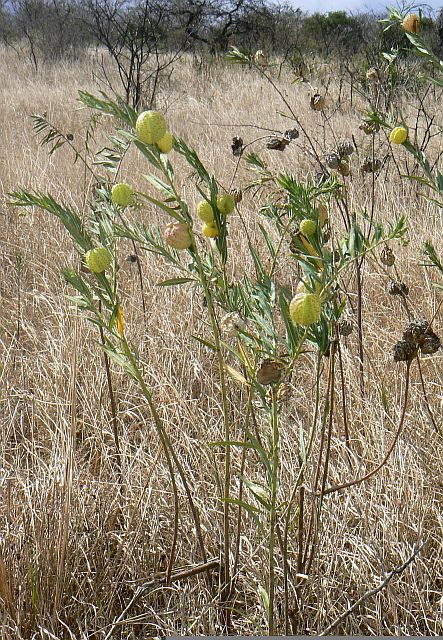
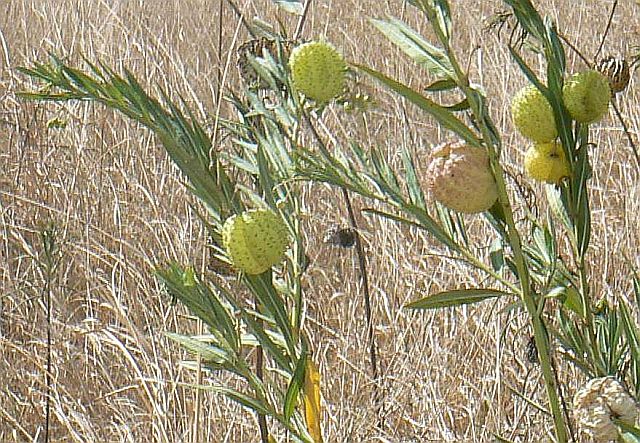
iMfolozi Game Reserve, KwaZulu-Natal
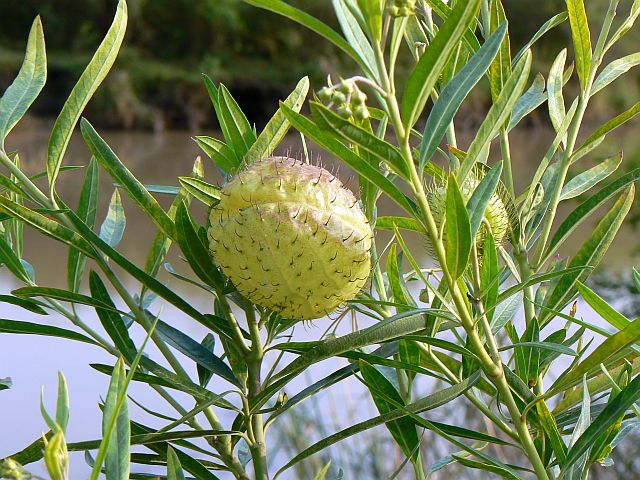
Balloonplant with capsules, Hluhluwe Game Reserve, KwaZulu-Natal
 © vinkie
© vinkie
Hluhluwe Game Reserve, KwaZulu-Natal
Description
This milkweed is a tender perennial, an upright, soft shrub 0.5 to 2 m tall with a fibrous rootstock and with a tree like form. Branches arise above a small, single-stemmed trunk. The branches are pale yellowish green and hollow. The leaves are light green, opposite, and narrowly oblong to lance-shaped.
Cream to white flowers in pendulous clusters are borne almost throughout the year but mainly during summer (November to April). The flowers are attractive and have a complicated structure. The petals bend strongly backwards, arching over the flower. In the centre of the flower is the corona, consisting of five pouched lobes that develop from the petals. The petals are white and the corona is suffused with pink or purple. The corona surrounds the male (stamens) and female (carpels composed of ovary, style & stigma) structures. The filaments of the stamens are fused to form a staminal column which encloses the female part. The female part consists of two free carpels, the tips of which are united and enlarged to form the style head. This is the yellowish, 5-lobed disc that can be seen at the centre of the flower. The anthers are fused to the style head. The pollen grains of each anther lobe are united to form two waxy masses known as pollinia or pollen sacs.
Flowers are followed by large spherical inflated fruits covered with soft spines, splitting to release many seeds, each with a tuft of long silky hairs attached at one end.
When broken, all parts of this plant exude milky white latex that is poisonous if ingested.
Taxonomy
The terminology for this plant is a little confusing. It is a native milkweed of South Africa and in 2001 its name was changed from Asclepias physocarpa to Gomphocarpus physocarpus to reflect that it is in the family of African milkweeds.
Gomphocarpus was previously in the family Asclepiadaceae, but this family is now classified as a subfamily, Asclepiadoideae, in the family Apocynaceae. Members of the Asclepiadoideae have highly specialised flowers with complicated pollination mechanisms, and include the milkweeds (Asclepias, Gomphocarpus, Xysmalobium), carrion flowers (Stapelia, Huernia and Hoodia) and curiosities like Bushman's pipe (Ceropegia spp.).
Distribution
Widespread in South Africa, occurring in the Western Cape, Eastern Cape, Kwa-Zulu Natal, Mpumalanga, Gauteng, Limpopo, North West, as well as in Swaziland, Botswana, Zimbabwe and Mozambique and northwards to Kenya.
Habitat
It is found growing in grassland and bushveld, often along roadsides and in disturbed areas, from the coast to 900 m above sea level. Although naturalised and widespread in South Africa for some time, it is an introduced weed, native to tropical Africa.
Ecology
Pollination of Gomphocarpus physocarpus and its Asclepiad relatives is highly specialised. It usually involves trapping the leg or proboscis of the pollinator so that the pollinia get attached to it, and then a similar process, in the next flower visited, to trap the insect again but this time to remove the pollinia. This species is pollinated by a wide variety of vespid wasps in the genera Belonogaster and Polistes. G. physocarpus is self-incompatible (i.e. it cannot set seed unless it receives pollen from a different plant), yet is also a successful weed in many places far from its original home.
The seeds are dispersed by wind, aided by the tuft of silky hairs attached to each seed.
Gomphocarpus physocarpus is a food plant for the larva of the African Monarch Butterfly (Danaus chrysippus orientis). The caterpillars are immune to the poisonous alkaloids in Gomphocarpus and have developed the ability to store them and pass them on to the pupa and adult butterfly, which use them to their own advantage and are foul-tasting and poisonous to predators. The anti-predator strategy of Gomphocarpus has thus been hijacked by the African monarch.
Links: Wikipedia, PlantZAfrica
Order: Gentianales. Family: Apocynaceae. Subfamily: Asclepiadoideae


iMfolozi Game Reserve, KwaZulu-Natal

Balloonplant with capsules, Hluhluwe Game Reserve, KwaZulu-Natal
 © vinkie
© vinkieHluhluwe Game Reserve, KwaZulu-Natal
Description
This milkweed is a tender perennial, an upright, soft shrub 0.5 to 2 m tall with a fibrous rootstock and with a tree like form. Branches arise above a small, single-stemmed trunk. The branches are pale yellowish green and hollow. The leaves are light green, opposite, and narrowly oblong to lance-shaped.
Cream to white flowers in pendulous clusters are borne almost throughout the year but mainly during summer (November to April). The flowers are attractive and have a complicated structure. The petals bend strongly backwards, arching over the flower. In the centre of the flower is the corona, consisting of five pouched lobes that develop from the petals. The petals are white and the corona is suffused with pink or purple. The corona surrounds the male (stamens) and female (carpels composed of ovary, style & stigma) structures. The filaments of the stamens are fused to form a staminal column which encloses the female part. The female part consists of two free carpels, the tips of which are united and enlarged to form the style head. This is the yellowish, 5-lobed disc that can be seen at the centre of the flower. The anthers are fused to the style head. The pollen grains of each anther lobe are united to form two waxy masses known as pollinia or pollen sacs.
Flowers are followed by large spherical inflated fruits covered with soft spines, splitting to release many seeds, each with a tuft of long silky hairs attached at one end.
When broken, all parts of this plant exude milky white latex that is poisonous if ingested.
Taxonomy
The terminology for this plant is a little confusing. It is a native milkweed of South Africa and in 2001 its name was changed from Asclepias physocarpa to Gomphocarpus physocarpus to reflect that it is in the family of African milkweeds.
Gomphocarpus was previously in the family Asclepiadaceae, but this family is now classified as a subfamily, Asclepiadoideae, in the family Apocynaceae. Members of the Asclepiadoideae have highly specialised flowers with complicated pollination mechanisms, and include the milkweeds (Asclepias, Gomphocarpus, Xysmalobium), carrion flowers (Stapelia, Huernia and Hoodia) and curiosities like Bushman's pipe (Ceropegia spp.).
Distribution
Widespread in South Africa, occurring in the Western Cape, Eastern Cape, Kwa-Zulu Natal, Mpumalanga, Gauteng, Limpopo, North West, as well as in Swaziland, Botswana, Zimbabwe and Mozambique and northwards to Kenya.
Habitat
It is found growing in grassland and bushveld, often along roadsides and in disturbed areas, from the coast to 900 m above sea level. Although naturalised and widespread in South Africa for some time, it is an introduced weed, native to tropical Africa.
Ecology
Pollination of Gomphocarpus physocarpus and its Asclepiad relatives is highly specialised. It usually involves trapping the leg or proboscis of the pollinator so that the pollinia get attached to it, and then a similar process, in the next flower visited, to trap the insect again but this time to remove the pollinia. This species is pollinated by a wide variety of vespid wasps in the genera Belonogaster and Polistes. G. physocarpus is self-incompatible (i.e. it cannot set seed unless it receives pollen from a different plant), yet is also a successful weed in many places far from its original home.
The seeds are dispersed by wind, aided by the tuft of silky hairs attached to each seed.
Gomphocarpus physocarpus is a food plant for the larva of the African Monarch Butterfly (Danaus chrysippus orientis). The caterpillars are immune to the poisonous alkaloids in Gomphocarpus and have developed the ability to store them and pass them on to the pupa and adult butterfly, which use them to their own advantage and are foul-tasting and poisonous to predators. The anti-predator strategy of Gomphocarpus has thus been hijacked by the African monarch.
Links: Wikipedia, PlantZAfrica
-
Poplap
- Posts: 1436
- Joined: Thu May 24, 2012 10:53 pm
- Location: Daar waar die bobbejane hul borshare kam...
- Contact:
Re: Africa Wild Flower Book - Order Gentianales
Kudu Lily Pachypodium saundersii
Order: Gentianales. Family: Apocynaceae
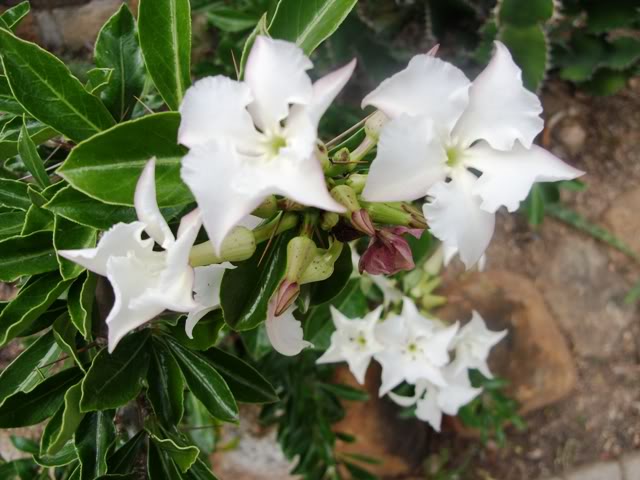
Kruger National Park © mposthumus
Description
P. saundersii is a succulent shrub with a large stem up to 1.5 m high. The exposed tuberous stem is up to 1 m in diameter and produces several narrow, thorny branches. The flowers are white, wax-like, tinged purplish pink and are borne from February to May. The glossy leaves are almost glabrous.
Distribution
It naturally occurs from northern KwaZulu-Natal and the Lebombo Range into Mpumalanga and Limpopo Provinces (South Africa) to Swaziland, southern Mozambique and Zimbabwe.
Habitat
This species grows in dry woodland amongst rocks or in rock crevices.
Order: Gentianales. Family: Apocynaceae

Kruger National Park © mposthumus
Description
P. saundersii is a succulent shrub with a large stem up to 1.5 m high. The exposed tuberous stem is up to 1 m in diameter and produces several narrow, thorny branches. The flowers are white, wax-like, tinged purplish pink and are borne from February to May. The glossy leaves are almost glabrous.
Distribution
It naturally occurs from northern KwaZulu-Natal and the Lebombo Range into Mpumalanga and Limpopo Provinces (South Africa) to Swaziland, southern Mozambique and Zimbabwe.
Habitat
This species grows in dry woodland amongst rocks or in rock crevices.
“Two things are infinite: the universe and human stupidity; and I'm not sure about the universe.”
― Albert Einstein
― Albert Einstein
Re: Africa Wild Flower Book - Order Gentianales
Kohoutia Kohautia cynanchica (Aandblommetjie)
Order: Gentianales. Family: Rubiaceae
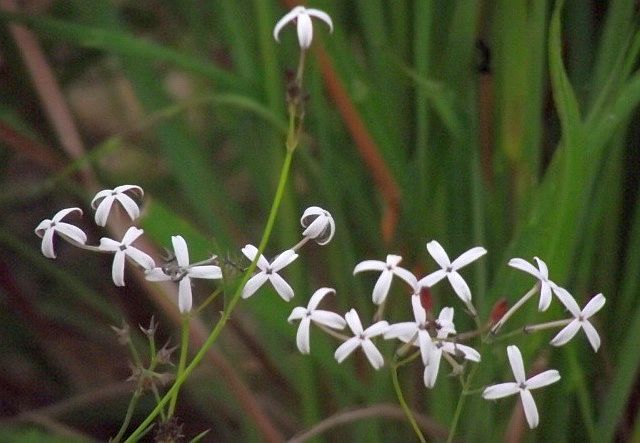 © mposthumus
© mposthumus
Lowveld Sour Bushveld of Pretoriuskop, Kruger National Park
Description
Erect or suberect wiry annual or perennial herb, up to 60 cm. Stems somewhat quadrangular, mostly hairless but with sparse rounded papillae along the ridges. Leaves opposite, often appearing whorled due to extra short shoot leaves, filiform to narrowly linear, up to 5 cm long, mostly hairless but with loosely arranged papillae; margin often rolled under. Flowers in loose branched heads. Corolla lobes usually 4, white, cream or rarely mauve-pink above, reddish-brown or olive-brown underneath and on the corolla tube; sweetly scented in the late afternoon and evening.
Distribution
Angola, Botswana Mozambique, Namibia, Zimbabwe, South Africa (Provincial distribution: Eastern Cape, Free State, Gauteng, KwaZulu-Natal, Limpopo, Mpumalanga, North West, Western Cape).
Habitat
Along dry river courses and wooded grassland.
Order: Gentianales. Family: Rubiaceae
 © mposthumus
© mposthumusLowveld Sour Bushveld of Pretoriuskop, Kruger National Park
Description
Erect or suberect wiry annual or perennial herb, up to 60 cm. Stems somewhat quadrangular, mostly hairless but with sparse rounded papillae along the ridges. Leaves opposite, often appearing whorled due to extra short shoot leaves, filiform to narrowly linear, up to 5 cm long, mostly hairless but with loosely arranged papillae; margin often rolled under. Flowers in loose branched heads. Corolla lobes usually 4, white, cream or rarely mauve-pink above, reddish-brown or olive-brown underneath and on the corolla tube; sweetly scented in the late afternoon and evening.
Distribution
Angola, Botswana Mozambique, Namibia, Zimbabwe, South Africa (Provincial distribution: Eastern Cape, Free State, Gauteng, KwaZulu-Natal, Limpopo, Mpumalanga, North West, Western Cape).
Habitat
Along dry river courses and wooded grassland.
Re: Africa Wild Flower Book - Order Gentianales
Pentanisia Pentanisia angustifolia
Order: Gentianales. Family: Rubiaceae

Ithala Game Reserve, KwaZulu-Natal
Description
Perennial herb. Stem erect, longish stalk, hairy. Leaves lanceolate or linear-lanceolate, glaucous-green, obtuse or narrower at the base. Flowers pale mauve, 15 mm five sided disposed in oblong, interrupted spikes in dense heads at the ends of the stems. The tubular blue or lilac flowers are
The leaves of the species are sessile or stalkless, narrowly lance-shaped, long and hairless. This distinguishes it from the other species found in parts of the same habitat: Pentanisia prunelloides with its broader, hairy leaves. P. prunelloides corolla lobes taper towards their tips, while P. angustifolia has oblong corolla lobes; a feature that can be seen by comparing flowers shown in this Album. Apart from these two species, there is a third South African one, growing in the Soutpansberg, P. sykesii.
Distribution
From the Eastern Cape to Limpopo includes Lesotho, Swaziland and Mozambique. Provincial distribution: Eastern Cape, Free State, Gauteng, KwaZulu-Natal, Limpopo, Mpumalanga, North West.
Habitat
In summer rainfall grassland.
Order: Gentianales. Family: Rubiaceae

Ithala Game Reserve, KwaZulu-Natal
Description
Perennial herb. Stem erect, longish stalk, hairy. Leaves lanceolate or linear-lanceolate, glaucous-green, obtuse or narrower at the base. Flowers pale mauve, 15 mm five sided disposed in oblong, interrupted spikes in dense heads at the ends of the stems. The tubular blue or lilac flowers are
The leaves of the species are sessile or stalkless, narrowly lance-shaped, long and hairless. This distinguishes it from the other species found in parts of the same habitat: Pentanisia prunelloides with its broader, hairy leaves. P. prunelloides corolla lobes taper towards their tips, while P. angustifolia has oblong corolla lobes; a feature that can be seen by comparing flowers shown in this Album. Apart from these two species, there is a third South African one, growing in the Soutpansberg, P. sykesii.
Distribution
From the Eastern Cape to Limpopo includes Lesotho, Swaziland and Mozambique. Provincial distribution: Eastern Cape, Free State, Gauteng, KwaZulu-Natal, Limpopo, Mpumalanga, North West.
Habitat
In summer rainfall grassland.
- Flutterby
- Posts: 44029
- Joined: Sat May 19, 2012 12:28 pm
- Country: South Africa
- Location: Gauteng, South Africa
- Contact:
Re: Africa Wild Flower Book - Order Gentianales
False Buttonweed Spermacoce natalensis
Order: Gentianales. Family: Rubiaceae. Subfamily: Rubioideae. Tribe: Spermacoceae

Mpenjati Nature Reserve on the South Coast, KwaZulu-Natal
Description
Erect or trailing perennial, 15-55 cm. Stems 4-ribbed, simple or sparsely branched. Leaves opposite, linear to oblong-elliptic, scabrid, glabrous except for very short hairs near the margins. Flowers in dense spherical clusters, one-sided at the nodes. Corolla white, tinged with pink; lobes triangular, densely hairy inside. Capsule almost squarish, glabrous, finely wrinkled, crowned with persistent lobes.
Distribution
From East Africa to South Africa (Eastern Cape, Gauteng, KwaZulu-Natal, Limpopo, Mpumalanga, North West).
Habitat
In grassland, along roadsides, and as a weed of cultivation.
Order: Gentianales. Family: Rubiaceae. Subfamily: Rubioideae. Tribe: Spermacoceae

Mpenjati Nature Reserve on the South Coast, KwaZulu-Natal
Description
Erect or trailing perennial, 15-55 cm. Stems 4-ribbed, simple or sparsely branched. Leaves opposite, linear to oblong-elliptic, scabrid, glabrous except for very short hairs near the margins. Flowers in dense spherical clusters, one-sided at the nodes. Corolla white, tinged with pink; lobes triangular, densely hairy inside. Capsule almost squarish, glabrous, finely wrinkled, crowned with persistent lobes.
Distribution
From East Africa to South Africa (Eastern Cape, Gauteng, KwaZulu-Natal, Limpopo, Mpumalanga, North West).
Habitat
In grassland, along roadsides, and as a weed of cultivation.
Re: Africa Wild Plant Book: Trees & Shrubs
Swazi Lily, Summer Impala Lily Adenium swazicum
Order Gentianales. Family: Apocynaceae
 © leachy
© leachy
Kruger National Park, Letaba
Description
Dwarf succulent with enlarged stem, sometimes partly below ground and few branches, up to 30 cm high, bearing clusters of succulent leaves up to 13 cm long x 3 cm wide, tapering to both ends, often folded lengthwise, softly downy below, losing hairs later. Inflorescence terminal, few-flowered, flowers appearing with leaves. Calyx up to 10 mm long; corolla tube up to 5 cm long, funnel-shaped, downy outside, lobes up to 3 cm long and wide, uniformly coloured pink to deep reddish purple; anthers with terminal tail up to 1,2 cm long, forking at base; ovary of two free parts, ovules numerous.
Distribution
Kruger National Park, Swaziland and Lebombo Mountains. Mainly from north of Komatipoort in South Africa through Swaziland to northern Kwazulu Natal.
Habitat
Deep clay soils predominantly derived from basalt and ryholite, in short mixed thornveld, 200-400 m.
Conservation Staus
Critically Endangered, the highest threat status that can be allocated. This species has assessed as Critically Endangered because of a massive reduction in its global population and further interest in harvesting this species for the medicinal and horticultural trades; it is also protected under NEMBA.
Based on aerial photographs 50% of its habitat has been transformed by sugar cane agriculture over the past two generations (60 years). It is currently declining due to harvesting for horticultural and medicinal purposes.
Adenium swazicum is confirmed to occur at the site of the proposed Safari Resort in the Kruger National Park on the southern border along the Crocodile River near Malelane Gate and along the original proposed road realignment route.
Do we care about the presence of critically endangered flora on sites for hotel or other development in a National Park or any Protected Area?



Order Gentianales. Family: Apocynaceae
 © leachy
© leachyKruger National Park, Letaba
Description
Dwarf succulent with enlarged stem, sometimes partly below ground and few branches, up to 30 cm high, bearing clusters of succulent leaves up to 13 cm long x 3 cm wide, tapering to both ends, often folded lengthwise, softly downy below, losing hairs later. Inflorescence terminal, few-flowered, flowers appearing with leaves. Calyx up to 10 mm long; corolla tube up to 5 cm long, funnel-shaped, downy outside, lobes up to 3 cm long and wide, uniformly coloured pink to deep reddish purple; anthers with terminal tail up to 1,2 cm long, forking at base; ovary of two free parts, ovules numerous.
Distribution
Kruger National Park, Swaziland and Lebombo Mountains. Mainly from north of Komatipoort in South Africa through Swaziland to northern Kwazulu Natal.
Habitat
Deep clay soils predominantly derived from basalt and ryholite, in short mixed thornveld, 200-400 m.
Conservation Staus
Critically Endangered, the highest threat status that can be allocated. This species has assessed as Critically Endangered because of a massive reduction in its global population and further interest in harvesting this species for the medicinal and horticultural trades; it is also protected under NEMBA.
Based on aerial photographs 50% of its habitat has been transformed by sugar cane agriculture over the past two generations (60 years). It is currently declining due to harvesting for horticultural and medicinal purposes.
Adenium swazicum is confirmed to occur at the site of the proposed Safari Resort in the Kruger National Park on the southern border along the Crocodile River near Malelane Gate and along the original proposed road realignment route.
Do we care about the presence of critically endangered flora on sites for hotel or other development in a National Park or any Protected Area?
Re: Africa Wild Flower Book - Order Gentianales
Bushveld Ghaap, Hoodia Hoodia gordonii (Bobbejaanghaap, Bergghaap, Bitterghaap, Bokhorings)
Order: Gentianales. Family: Apocynaceae. Subfamily: Asclepiadoideae. Tribe: Stapeliae

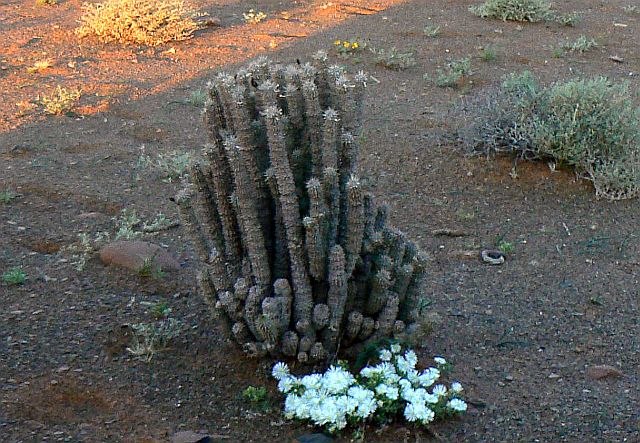
Tankwa Karoo National Park

Richtersveld National Park
Description
Hoodia gordonii is a leafless spiny erect succulent plant with a watery latex. In the early stages only one stem is produced but at a later stage the plant starts branching. Mature plants can have as many as 50 individual branches and weigh as much as 30 kg. Plants under ideal conditions can attain a height of 1 m. Stems thick. cylindrical. Flowers are borne on or near the terminal apex (top part of the plant). The flowers are large and have a carrion-like smell (smell similar to rotten meat). Flowers vary in colour from pale straw to dark maroon. Flowers are normally borne in August or September. Flowers can reach a diameter of 75 mm. Seed is produced in October and November.
Distribution
It grows naturally in Namibia, Botswana, Angola and the dry margins of the summer rainfall region of South Africa (Free State, Northern Cape, Western Cape).
It has undergone decline since 2001 as a result of indiscriminate harvesting for its appetite suppressant properties. International and national demand was particularly high between 2004 and 2006 and as a result of the high economic value of this species even remote areas of its distribution range are suspected to have been harvested.
Habitat
Desert, Nama Karoo, Savanna, Succulent Karoo. It occurs in a wide variety of arid habitats from coastal to mountainous, also on gentle to steep shale ridges, found from dry, rocky places to sandy spots in riverbeds. The plant appears to have a wide tolerance of growing habitats, found in deep Kalahari sands, on dry stony slopes or flats and under the protection of xerophytic bushes.
Medicinal properties
The use of Hoodia spp. has long been known by the indigenous peoples of Southern Africa, who infrequently use these plants for treating indigestion and small infections. But it is their centuries-old use of the meat of the plant to suppress appetite on long hunting trips in the Kalahari Desert that has stimulated the most interest.
In 1977, the South African Council for Scientific and Industrial Research (CSIR) isolated the ingredient in hoodia—now known as P57—which is responsible for its appetite-suppressant effect, and patented it in 1996. The CSIR then granted United Kingdom-based Phytopharm a license, and they collaborated with the pharmaceutical company Pfizer to isolate active ingredients from the extracts and look into synthesizing them for use as an appetite suppressant. Pfizer released the rights to the primary ingredient in 2002. Paul Hutson, associate professor in the University of Wisconsin–Madison School of Pharmacy, told the Wisconsin State Journal, "For Pfizer to release something dealing with obesity suggests to me that they felt there was no merit to its oral use". Pfizer states that development on P57, the active ingredient of hoodia, was stopped due to the difficulty of synthesizing P57. Jasjit Bindra, lead researcher for hoodia at Pfizer, states there were indications of unwanted effects on the liver caused by other components, which could not be easily removed from the supplement, adding "Clearly, hoodia has a long way to go before it can earn approval from the Food and Drug Administration (FDA). Until safer formulations are developed, dieters should be wary of using it."
In 2002, CSIR officially recognized the San tribespeople’s rights over hoodia, allowing them to take a percentage of the profits and any spin-offs resulting from the marketing of hoodia. Hoodia gordonii is a protected plant which may only be wild-harvested by individuals and the few companies who have been granted a license.
Order: Gentianales. Family: Apocynaceae. Subfamily: Asclepiadoideae. Tribe: Stapeliae


Tankwa Karoo National Park

Richtersveld National Park
Description
Hoodia gordonii is a leafless spiny erect succulent plant with a watery latex. In the early stages only one stem is produced but at a later stage the plant starts branching. Mature plants can have as many as 50 individual branches and weigh as much as 30 kg. Plants under ideal conditions can attain a height of 1 m. Stems thick. cylindrical. Flowers are borne on or near the terminal apex (top part of the plant). The flowers are large and have a carrion-like smell (smell similar to rotten meat). Flowers vary in colour from pale straw to dark maroon. Flowers are normally borne in August or September. Flowers can reach a diameter of 75 mm. Seed is produced in October and November.
Distribution
It grows naturally in Namibia, Botswana, Angola and the dry margins of the summer rainfall region of South Africa (Free State, Northern Cape, Western Cape).
It has undergone decline since 2001 as a result of indiscriminate harvesting for its appetite suppressant properties. International and national demand was particularly high between 2004 and 2006 and as a result of the high economic value of this species even remote areas of its distribution range are suspected to have been harvested.
Habitat
Desert, Nama Karoo, Savanna, Succulent Karoo. It occurs in a wide variety of arid habitats from coastal to mountainous, also on gentle to steep shale ridges, found from dry, rocky places to sandy spots in riverbeds. The plant appears to have a wide tolerance of growing habitats, found in deep Kalahari sands, on dry stony slopes or flats and under the protection of xerophytic bushes.
Medicinal properties
The use of Hoodia spp. has long been known by the indigenous peoples of Southern Africa, who infrequently use these plants for treating indigestion and small infections. But it is their centuries-old use of the meat of the plant to suppress appetite on long hunting trips in the Kalahari Desert that has stimulated the most interest.
In 1977, the South African Council for Scientific and Industrial Research (CSIR) isolated the ingredient in hoodia—now known as P57—which is responsible for its appetite-suppressant effect, and patented it in 1996. The CSIR then granted United Kingdom-based Phytopharm a license, and they collaborated with the pharmaceutical company Pfizer to isolate active ingredients from the extracts and look into synthesizing them for use as an appetite suppressant. Pfizer released the rights to the primary ingredient in 2002. Paul Hutson, associate professor in the University of Wisconsin–Madison School of Pharmacy, told the Wisconsin State Journal, "For Pfizer to release something dealing with obesity suggests to me that they felt there was no merit to its oral use". Pfizer states that development on P57, the active ingredient of hoodia, was stopped due to the difficulty of synthesizing P57. Jasjit Bindra, lead researcher for hoodia at Pfizer, states there were indications of unwanted effects on the liver caused by other components, which could not be easily removed from the supplement, adding "Clearly, hoodia has a long way to go before it can earn approval from the Food and Drug Administration (FDA). Until safer formulations are developed, dieters should be wary of using it."
In 2002, CSIR officially recognized the San tribespeople’s rights over hoodia, allowing them to take a percentage of the profits and any spin-offs resulting from the marketing of hoodia. Hoodia gordonii is a protected plant which may only be wild-harvested by individuals and the few companies who have been granted a license.
Re: Africa Wild Flower Book - Order Gentianales
Hoodia Hoodia currorii lugardii
Order: Gentianales. Family: Apocynaceae. Subfamily: Asclepiadoideae. Tribe: Stapeliae
 © Moggiedog
© Moggiedog
Makgadikgadi Pans, Botswana
Description
Robust multi-stemmed succulent perennial. It can grow to a height of 60 cm. Stems usually erect, branching from the base, cylindrical, ribbed by up to 30 vertical rows of tubercles, each tipped by a single whitish spine. Flowers in clusters near the apex of the stems, opening in succession. Corolla shallowly cup-shaped, glabrous on the outside, papillate on the inside. Corona 2-seriate, arising from the staminal column. Outer lobes bifid at the apex; inner lobes, shorter than the anthers.
Distribution
Central Botswana, Namibia, aouthern Zimbabwe and South Africa (Limpopo).
Habitat
In dry woodland and along the pan edges.
Links:
Succulent Flora of Southern Africa
Order: Gentianales. Family: Apocynaceae. Subfamily: Asclepiadoideae. Tribe: Stapeliae
 © Moggiedog
© MoggiedogMakgadikgadi Pans, Botswana
Description
Robust multi-stemmed succulent perennial. It can grow to a height of 60 cm. Stems usually erect, branching from the base, cylindrical, ribbed by up to 30 vertical rows of tubercles, each tipped by a single whitish spine. Flowers in clusters near the apex of the stems, opening in succession. Corolla shallowly cup-shaped, glabrous on the outside, papillate on the inside. Corona 2-seriate, arising from the staminal column. Outer lobes bifid at the apex; inner lobes, shorter than the anthers.
Distribution
Central Botswana, Namibia, aouthern Zimbabwe and South Africa (Limpopo).
Habitat
In dry woodland and along the pan edges.
Links:
Succulent Flora of Southern Africa


